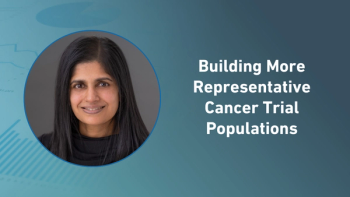
AI Levels the Playing Field in Trial Recruitment
In this video interview, Kyle McAllister, co-founder, CEO, Trially, shares real-world examples of AI transforming clinical trial recruitment.
In a recent video interview with Applied Clinical Trials, Kyle McAllister, co-founder, CEO, Trially, discussed the impact of funding cuts on underrepresented populations in medical research, emphasizing the importance of diversity-focused research. He highlighted the challenges created by budget cuts, particularly in patient recruitment and retention, due to reduced support staff. McAllister noted that artificial intelligence (AI) and new technologies like telemedicine are crucial for addressing these challenges by automating tasks and improving efficiency. He provided examples of AI's success in reducing chart review time and increasing patient enrollment in studies.
ACT: Are there examples you've seen where AI or digital tools have already made an impact on trial recruitment efficiency or targeting?
McAllister: Absolutely, we're watching it every day. Like I said, the patient screening capability that we're rolling out to sites, we've seen sites decrease their chart review time by 90%. We also stack rank patients, so we can say, “Hey, these are the patients that fit,” and stack rank them based on their fit. That alone cuts 60-70% of the screen fail rate, because we're not spending time talking to patients that won't be a good fit for the study. Those are two really quick hit outcomes we've seen.
One really interesting, specific example that I love talking about, because I think it's just such a perfect example of how AI can be helpful in this space, is we have a, I would say, mid-size cardiology clinic that we work with. They have this really complex heart failure study that they've been recruiting for years. They've been on the study for—before we got connected—a year and a half, they had one patient recruited. The study was really struggling. The sponsor is breathing down their necks trying to get more patients into the study. After we got connected, it's been four months, they've now got seven enrollees in the trial, and now the sponsor is coming back like, “How did you do this? How could you possibly make this happen?” The really cool part, the part that gets me really excited, having spent time in the site world myself, is that was one research coordinator at one mid-sized site, and the second-best recruiting site on the study after her, is a giant academic institution with 20 CRCs coming through a huge database of people. It just really shows the power of really leveraging these tools can up-level a single individual to cover a lot of ground. Back to all the talk we've had about resourcing, it does take some lift off and make it so one person can achieve more. That’s just a handful of examples we've seen on the ground.
Newsletter
Stay current in clinical research with Applied Clinical Trials, providing expert insights, regulatory updates, and practical strategies for successful clinical trial design and execution.




